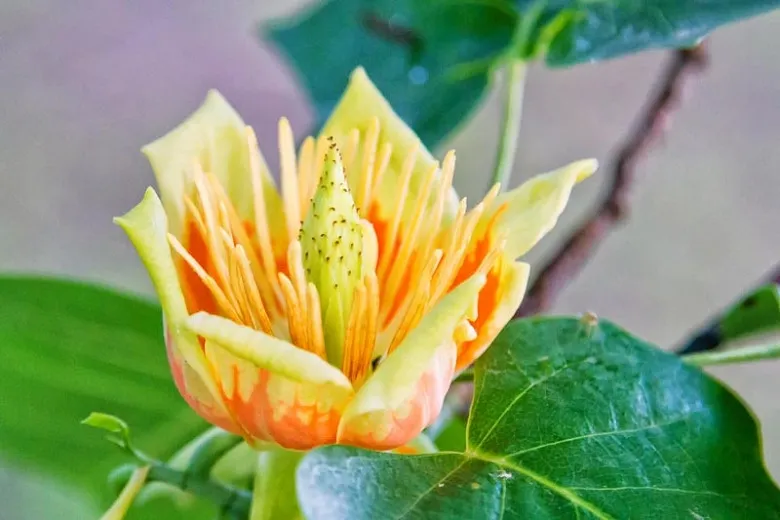Liriodendron tulipifera (Tulip Tree) is a magnificent deciduous tree known for its stately presence, unique flowers, and vibrant foliage.

Here’s a closer look at its key features and care requirements:
Description:
- The Tulip Tree is tall and stately, featuring a pyramidal habit when young and becoming oval-rounded as it matures.
- In late spring to early summer, the tree produces striking tulip-shaped flowers that are yellowish-green in color. Each flower is about 3 inches (7 cm) across and features orange markings at the base of each petal.
- The flowers appear after the leaves on mature trees, typically those that are at least 12-15 years old.
- The glossy foliage is composed of 4-lobed, flat-topped, bright green leaves that can reach up to 8 inches (20 cm) in length.
- During the fall, the leaves transition to a brilliant golden yellow color, adding a stunning display of autumn color.
- The tree also produces cone-like fruit that provides winter interest.
Size and Growth Habit:
- Tulip Trees can grow up to 60-80 feet (18-24 meters) in height and 30-40 feet (9-12 meters) in width.
Cultural Requirements:
- This tree thrives in full sun, making it an ideal choice for sunny locations.
- It prefers organically rich, moist, and well-drained soils with an acidic pH.
- While the tree can tolerate moderately moist and well-drained soils, it generally does not perform well in very wet or very dry conditions.
Landscape Uses:
- The Tulip Tree is an excellent choice as a shade tree or specimen tree in large landscapes.
- Its tall, pyramidal shape and unique flowers make it a standout feature in any garden.
Pest and Disease Resistance:
- This tree is generally low maintenance and is not highly susceptible to serious insect or disease issues.
- It is also resistant to deer and rabbits, which can be a common concern in many landscapes.
Propagation and Native Range:
- Tulip Trees can be propagated through seed or grafting.
- They are native to eastern North America.
Cultural Notes:
- Tulip Trees are the state trees of Kentucky, Tennessee, and Indiana.
- The tree is known to be a favorite nesting spot for birds, and its flowers attract hummingbirds.
- Native Americans historically utilized the straight, column-like trunks of Tulip Trees to create dugout canoes.
In summary, Liriodendron tulipifera (Tulip Tree) is a majestic tree that stands out for its impressive height, unique tulip-shaped flowers, and vibrant foliage. Its adaptability to various soil conditions and relatively low-maintenance nature make it a valuable addition to larger landscapes seeking both aesthetic and ecological benefits.








